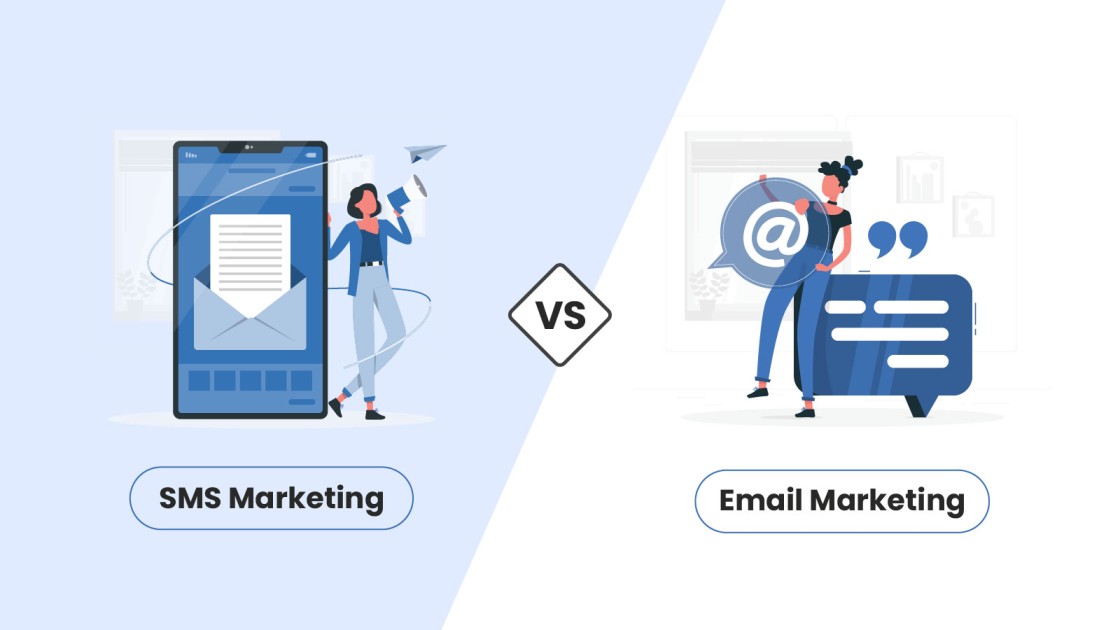
SMS Marketing Vs Email Marketing: Which Channel Is More Trustworthy?
Now businesses have an array of marketing channels at their disposal to connect with their target audience. Two prominent contenders in the realm of direct communication are SMS marketing and email marketing. Both channels offer unique advantages, but SMS Marketing Vs Email Marketing- How do they differ?
The main difference lies in the medium of communication. SMS marketing uses text messages for immediate and concise communication, while email marketing utilizes electronic mails for broader and more detailed content delivery.
In this blog post, we delve into the world of SMS and email marketing, exploring their strengths, limitations, and impact on building trust with consumers.
Difference Between SMS Marketing Vs Email Marketing
| SMS Marketing | Email Marketing | |
| Cost-effectiveness | Generally higher cost per message. | Lower cost per email, making it budget-friendly. |
| Reach | More direct communication to opt-in recipients. | Wider reach as most people have email accounts. |
| Open Rates | High open rates, messages are read within minutes. | Lower open rates compared to SMS. |
| Message Length | Limited to 160-320 characters. | Can accommodate longer and more detailed content. |
| Personalization | Limited personalization options due to character constraints. | Extensive personalization capabilities, allowing dynamic content. |
| Engagement | Immediate and highly engaging. | Effective for engagement, but might require more compelling content. |
| Timing | Ideal for time-sensitive promotions and urgent updates. | Offers flexibility in timing, but might lack immediacy. |
| Content Type | Suitable for concise messages and quick calls-to-action. | Allows for long-form content, multimedia elements, and educational materials. |
| Automation | Offers automation features for scheduled and triggered messages. | Provides robust automation capabilities for drip campaigns and personalized workflows. |
What Is SMS Marketing?
SMS marketing is a powerful digital marketing strategy that utilizes short message service (SMS) or text messages to reach and engage with a target audience.

In SMS marketing, businesses send promotional content, updates, offers, and alerts directly to the mobile devices of subscribers who have opted to receive these messages. With its concise and immediate nature, SMS marketing boasts higher open rates and engagement than other marketing channels. This direct communication enables businesses to deliver time-sensitive information, personalized offers, and quick calls to action, driving conversions and enhancing customer relationships.
Benefits Of SMS Marketing
- High Open Rates: SMS marketing enjoys exceptionally high open rates, with most messages being read within minutes of receipt. This immediate attention ensures that your message reaches a wide audience promptly.
- Increased Engagement: The concise and direct nature of SMS messages encourages higher engagement levels. With limited characters, recipients are more likely to read, respond, and take immediate action on your marketing campaigns.
- Targeted Audience: SMS marketing allows you to reach a highly targeted audience. Since subscribers must opt-in to receive messages, you can tailor content to their preferences, leading to more relevant and personalized communication.
- Cost-Effective: Compared to traditional advertising channels, SMS marketing is cost-effective, making it accessible to businesses of all sizes. It eliminates printing and postage expenses while delivering instant communication.
- Quick Delivery: SMS messages are delivered instantly, making it an ideal channel for time-sensitive promotions, flash sales, event reminders, and urgent updates. This immediacy ensures that your audience receives critical information promptly.
- High Conversion Rates: With its personalized and direct approach, SMS marketing often results in higher conversion rates. Whether driving traffic to your website, promoting a special offer, or encouraging in-store visits, SMS can be a powerful tool for converting leads into customers.
- Easy Opt-In and Opt-Out: Subscribers can opt in or out of SMS campaigns anytime. This transparency and control empower customers, fostering a positive brand image and maintaining compliance with relevant regulations.
Disadvantages Of SMS Marketing
- Limited Content: The character limit of SMS messages (typically 160 characters) can be a significant drawback for SMS marketing. It restricts the amount of information businesses can convey, making delivering complex or detailed messages challenging.
- Cost Consideration: While SMS marketing is generally cost-effective, especially compared to traditional marketing channels, costs can add up with large subscriber lists or international messaging. Businesses must carefully manage expenses to ensure a positive return on investment.
- Device Compatibility: While SMS is widely accessible, some older or non-smartphone devices may not fully support multimedia content or links, limiting the engagement potential for certain recipients.
- Timing Sensitivity: The immediate nature of SMS can backfire if messages are sent at inconvenient times, leading to a negative user experience. Careful consideration of timing is essential to ensure messages are well-received.
- No Visual Appeal: Unlike email marketing, SMS lacks visual elements such as images or multimedia, making it less suitable for visually-driven marketing campaigns.
What Is Email Marketing?
Email marketing is a digital marketing strategy that involves using email as a communication channel to reach and engage with a target audience. It enables businesses and organizations to send commercial messages, promotional content, updates, newsletters, and other relevant information directly to the email inboxes of subscribers who have willingly opted to receive such communications.

Email marketing is a versatile and cost-effective method for businesses to nurture customer relationships, generate leads, drive website traffic, and promote products or services. It allows for personalized and targeted messaging, enabling businesses to tailor content based on user preferences and behavior.
Benefits Of Email Marketing
- Wide Reach: Email marketing allows businesses to reach a large audience instantly, as billions of people worldwide use email regularly, making it a widely accessible communication channel.
- Cost-Effective: Compared to traditional marketing methods, email marketing is highly cost-effective. It eliminates printing and postage expenses, reducing overall marketing costs significantly.
- Targeted Messaging: With email marketing, businesses can segment their audience based on demographics, behavior, and preferences, allowing for highly targeted and personalized messaging that resonates with recipients.
- Increased Engagement: Personalized and relevant content in emails fosters higher engagement rates. Call-to-action buttons and hyperlinks drive recipients to take desired actions, such as visiting a website or purchasing.
- Easy Automation: Email marketing platforms offer automation features, allowing businesses to schedule and send emails at specific times or trigger emails based on user actions, saving time and effort.
- Measurable Results: Email marketing provides comprehensive analytics, enabling businesses to track the performance of their campaigns. Metrics like open rates, click-through rates, and conversion rates help gauge the effectiveness of email campaigns.
- Enhanced Customer Relationships: Consistent and valuable email communication helps businesses build and strengthen customer relationships, increasing brand loyalty and customer retention.
- Real-Time Communication: Email marketing allows businesses to communicate with their audience in real time, making it ideal for time-sensitive promotions, announcements, and event reminders.
Disadvantages Of Email Marketing
- Spam Filters: Email marketing messages may get caught in spam filters, preventing them from reaching the intended recipients’ inboxes. This can reduce the effectiveness of the campaign and lower open rates.
- Inbox Overload: With the abundance of emails that individuals receive daily, it’s easy for marketing messages to get buried or overlooked in crowded inboxes. Standing out amidst the competition can be a challenge.
- Unsubscribes: Some recipients may choose to unsubscribe from email lists, reducing the pool of engaged subscribers and potentially leading to a decline in audience reach.
- Regulations: Email marketing is subject to various data protection and anti-spam laws, such as GDPR and CAN-SPAM Act, which businesses must comply with to avoid legal consequences.
- Limited Personalization: While email marketing allows for personalization, it may not match the level of personal connection that some other marketing channels, like SMS, can achieve.
- Initial Building of Email Lists: Building a quality email list requires time and effort. Gaining subscribers who are genuinely interested in the brand and its offerings is essential to the success of email marketing campaigns.
SMS Marketing Vs Email Marketing: Major Differences

| Key Stats | SMS Marketing | Email Marketing |
| Open rate | 95% | 20% |
| Click-through rate | 25% to 45% | 2% to 10% |
| Response time | 90 seconds | 90 minutes |
| Spam rate | 5% | 80% |
| Cost per campaign (approx.) | $0.05 – $0.20 | $0.01 – $0.10 |
| Global reach | High | High |
| Conversion rate | 3% to 10% | 1% to 5% |
| Opt-out rate | 5% | 1% |
| Targeting capabilities | Limited | Advanced |
| Message length limit | 160 characters | Unlimited |
Medium
The primary difference between SMS and email marketing is the method used to reach the target demographic. Email marketing is distributing promotional materials through the Internet, including emails, newsletters, updates, and offers. It provides a more robust platform for organizations to produce visually engaging emails with multimedia components like photos, videos, and hyperlinks. On the other hand, short messaging service (SMS) marketing uses text messages to provide immediate and specific information to mobile customers. SMS is a strong tool for rapid, time-sensitive marketing because of its immediacy and conciseness, whereas email offers a more open canvas for communication.
Reach
When deciding between email and SMS marketing, it’s important to think about the potential audience size of each. Since most people have email accounts and use email often for both personal and professional purposes, email marketing generally reaches a wider audience. Email marketing allows companies to reach out to a wide audience. However, it is important to remember that email inboxes may grow full, and messages may get buried or overlooked in the shuffle.
On the other hand, SMS marketing allows for more specific and direct consumer interaction. In this way, only those who have shown an interest in getting updates from the company would receive text messages since they will be required to “opt-in” to receiving them. SMS messages are often received and read within minutes. Thus this focused strategy allows for more tailored messaging and improved engagement rates.
Open Rates
A marketing channel’s open rate is the proportion of intended receivers who click on and read an email. The open rate for SMS campaigns is far greater than email marketing. SMS messages are sent instantly, so their receivers treat them as urgent and read them immediately. On the other hand, emails may wait in an inbox for a long time to be opened.
Length
The character count for messages sent by SMS is much lower than that of emails. Email marketing enables companies to create longer and more in-depth communications, making it ideal for providing in-depth descriptions of goods, services, and deals. Businesses may improve the customer experience by including visuals, detailed explanations, and downloadable files.
However, SMS marketing has a character restriction set by cell carriers, which limits the length of messages sent. Although the maximum length of an SMS is 160 characters, this may be increased to 320 characters by concatenating messages on various platforms. Despite this restriction, companies may still utilize SMS marketing to send short yet powerful messages to grab their target audience’s attention right away.
Engagement
Consumer participation is a major indicator of marketing success. The succinct and direct style of SMS marketing helps to increase participation. Higher response rates may be achieved via SMS notifications since receivers are more inclined to take prompt action upon receiving the message. SMS’s efficacy as a medium for instantaneous communication is owed in part to the feeling of urgency that comes with using it.
On the other hand, email marketing may more easily include multimedia and interactive components, which boost participation. To prompt readers to take action, businesses may embed call-to-action buttons, links, videos, and pictures in their emails. The difficulty is that email inboxes may become full, so you’ll need to make sure your subject line and body material stand out.
Consent is Required
The need for a recipient to opt in before receiving messages is a key distinction between email and SMS marketing. Due to privacy concerns and the potential for spam, SMS marketing is subject to stricter rules in many areas. Firms often need receivers’ opt-in permission before sending promotional SMS messages to comply with these rules.
In contrast, the opt-in procedure for email marketing is often less stringent but still subject to different privacy restrictions. There are several ways for businesses to get email addresses, such as via website sign-ups, lead magnets, and client registrations. However, to prevent any possible legal difficulties, firms must comply with anti-spam legislation and gain appropriate authorization from recipients.
Personalization
Modern marketing relies heavily on personalization to improve the consumer experience and forge deeper relationships between brands and their target markets. Personalization is possible in great depth with email marketing. Using recipient names, segmentation, and dynamic content, businesses can send more relevant emails to their subscribers depending on their interests, actions, and demographics.
Due to the short nature of text messages, personalization possibilities are restricted in SMS marketing. However, companies may still take advantage of personalization by, for example, addressing customers by name or providing them with discount coupons that are specific to them. While SMS has drawbacks, the speed with which messages are sent might give the impression that they were written just for the receiver.
Deliverability
For a marketing effort to be successful, messages must be delivered to their target audience. SMS marketing often has higher deliverability rates than email marketing. Due to the fact that SMS messages are not filtered by the same spam filters and mailbox algorithms as emails, they have a far greater deliverability rate.
On the other hand, spam filters, email authentication, sender reputation, and email service provider rules all impact whether or not an email gets sent. The likelihood that the intended recipient will read an email is decreased if it is filtered out as spam or prohibited outright.
Regulation
Email and SMS marketing regulations exist to prevent unwanted messages from reaching consumers. Regarding marketing, however, the rules may be more stringent for SMS because of the personal nature of text messages and the possibility of privacy breaches.
Anti-spam legislation, such as the CAN-SPAM Act in the US and the General Data Protection Regulation (GDPR) in Europe, also applies to email marketing. Emails from businesses must have working unsubscribe links and real-world addresses. Fines and other legal repercussions may occur for violating these rules.
How Much Do SMS & Email Marketing Campaigns Cost?
SMS marketing campaigns are generally cost-effective. Sending a weekly text message to a list of 10,000 subscribers may cost around $400-500. However, the exact cost per message can vary depending on factors such as the wireless carrier and service package chosen by the business. It’s essential to consider the pricing structure of the SMS marketing service provider and any additional fees for features like automation or personalization.
On the other hand, email marketing campaigns can vary widely in cost, depending on the scale and complexity of the campaign. Email marketing platforms typically offer various pricing tiers based on the number of subscribers or emails sent per month. The cost may range from a few dollars per month for small lists to several hundred or more for larger lists with extensive features and functionalities.
Both SMS and email marketing offer cost-effective solutions for businesses of all sizes, allowing them to reach their audience efficiently and drive engagement.
Strategies To Use Both Email & SMS Marketing At The Same Time
Integrating email and SMS marketing can create a powerful and cohesive marketing strategy, leveraging the strengths of each channel to maximize reach, engagement, and conversion rates. Here are some effective strategies to use both email and SMS marketing simultaneously
Cross-Channel Promotion
Use email to promote SMS subscriptions and vice versa. Include a call-to-action in emails encouraging subscribers to opt-in for SMS updates, and in SMS messages, provide a link to join the email list for more comprehensive content. This cross-channel promotion helps expand your audience reach and ensures customers can choose their preferred communication method.
Segmentation and Personalization
Utilize data from both channels to segment your audience effectively—tailor content based on customer preferences, behavior, and engagement history. Personalized emails and SMS messages create a more meaningful connection with subscribers, enhancing the overall customer experience.
Timing and Cadence
Coordinate the timing and frequency of emails and SMS messages to avoid overwhelming subscribers. Use email for more comprehensive and less time-sensitive content, while SMS can be employed for urgent updates or time-sensitive promotions. Consistency in messaging across channels fosters brand recognition.
Abandoned Cart and Remarketing
Combine email and SMS for abandoned cart reminders and remarketing efforts. Please send an email to remind customers about their abandoned carts and follow up with an SMS reminder for a quicker response. This dual approach can help recover lost sales and increase conversion rates.
Event Reminders and Confirmations
For events, appointments, or webinars, use email to send detailed information and reminders leading up to the event. Send an SMS confirmation and a last-minute reminder on the event day to ensure high attendance rates.
Drip Campaigns
Implement drip campaigns using both email and SMS. Gradually nurture leads with a series of automated emails containing valuable content. Complement this with SMS messages offering exclusive deals or limited-time offers, enticing subscribers to act promptly.
Feedback and Surveys
Use email to distribute customer satisfaction surveys or feedback forms with a link to an online survey. Follow up with SMS reminders for customers who have not responded, increasing survey completion rates.
Exclusive Offers and Discounts
Send exclusive offers or discounts via email, then follow up with SMS notifications to create a sense of urgency and drive immediate action. This two-step approach can lead to higher conversion rates and increased sales.
Social Media Integration
Leverage both channels to promote social media engagement. Encourage email subscribers to follow your social media profiles for updates and use SMS to announce contests or exclusive social media giveaways.
Transactional Messaging
Use email for transactional messages, such as order confirmations and shipping updates. Simultaneously, send an SMS notification for critical updates, ensuring customers are well-informed about their purchases.
Customer Support
Utilize both email and SMS to provide customer support. Allow customers to submit support queries via email and send SMS updates when their inquiries are resolved, keeping them informed throughout the process.
Opt-In Campaigns
When starting SMS marketing, run an opt-in campaign through email to acquire consent from existing email subscribers. Conversely, SMS encourages email sign-ups by offering exclusive content or discounts upon subscription.
Businesses can create a cohesive and effective marketing strategy by strategically combining email and SMS marketing. Maintaining consistency, relevance, and personalization while respecting subscribers’ communication preferences is key. Utilizing the unique advantages of each channel will result in enhanced customer engagement, increased conversions, and, ultimately, business growth.
When Should You Use Email Marketing Campaigns?
Here are some key situations when you should consider using an email marketing campaign:
- Product or Service Updates: Email your audience about new product launches, service enhancements, or updates. This ensures that customers are aware of the latest offerings and can lead to increased sales and engagement.
- Promotions and Discounts: Email is an excellent platform for delivering exclusive promotions, discounts, and special offers to your subscribers. Use email campaigns to incentivize purchases, reward loyalty, and drive traffic to your website or physical store.
- Event Invitations: For webinars, workshops, or in-person events, use email to send invitations and event details to your target audience. Email campaigns boost event attendance and create a sense of anticipation among recipients.
- Content Marketing: Email marketing is an effective way to distribute valuable content, such as blog posts, articles, videos, and infographics. Use email campaigns to share educational content that aligns with your audience’s interests and establishes your brand as an industry authority.
- Lead Nurturing: Implement automated email drip campaigns to nurture leads and move them through the sales funnel. Share relevant content and personalized messages to build trust and keep prospects engaged until they are ready to purchase.
- Customer Onboarding: After a customer makes a purchase, use email campaigns to welcome them onboard, provide order confirmations, and offer helpful resources to ensure a smooth customer experience.
- Cart Abandonment Recovery: Combat cart abandonment by sending reminder emails to customers who left items in their shopping carts. Use these campaigns to entice them to return and complete their purchase.
- Customer Feedback and Surveys: Email is an effective channel to gather customer feedback and conduct surveys. Use email campaigns to seek input, understand customer preferences, and improve your products or services.
- Re-Engagement Campaigns: Target inactive or disengaged subscribers with re-engagement email campaigns. Offer special incentives or exclusive content to entice them back into your marketing fold.
- Holiday and Seasonal Campaigns: Capitalize on holidays and special occasions to run targeted email campaigns. Create festive offers and thematic content that resonate with your audience during specific seasons.
When Should You Use SMS Marketing Campaigns?
SMS marketing campaigns are ideal for situations that require immediate communication, short messaging, and a high level of engagement. Here are some key scenarios when you should use an SMS marketing campaign:
- Time-Sensitive Promotions: SMS is perfect for delivering time-sensitive promotions and limited-time offers. Use SMS to create a sense of urgency and encourage immediate action from your audience.
- Flash Sales: Notify customers about flash sales, one-day deals, or last-minute discounts through SMS. The immediate delivery ensures that recipients can take advantage of the offer promptly.
- Appointment Reminders: Use SMS to send appointment reminders to customers, reducing no-shows and improving overall customer satisfaction.
- Event Updates: Keep event attendees informed about event details, schedule changes, or location updates through SMS messages, ensuring a smooth and well-coordinated event experience.
- Order Notifications: Send SMS alerts to customers to confirm order placements, shipping updates, and delivery notifications. This real-time communication keeps customers informed about their purchases.
- Customer Surveys and Feedback: Gather customer feedback and conduct quick surveys through SMS. With higher open rates, SMS can yield faster and more efficient responses.
- Abandoned Cart Recovery: Re-engage customers who abandoned their carts by sending personalized SMS reminders with enticing offers or discounts to encourage them to complete their purchases.
- Exclusive Content or Previews: Offer exclusive content, sneak peeks, or early access to new products through SMS, rewarding loyal customers and building excitement.
- Emergency Notifications: In urgent situations or emergencies, use SMS to quickly communicate important information, ensuring that recipients receive critical updates promptly.
- Two-Factor Authentication (2FA): SMS is commonly used for 2FA in online accounts, adding an extra layer of security by sending verification codes to users’ mobile devices.
- Personalized Promotions: Utilize SMS marketing to send personalized promotions based on customer behavior and preferences, increasing the chances of conversion.
- Short Surveys or Polls: Conduct quick and straightforward surveys or polls through SMS to gather customer opinions or preferences efficiently.
Is Email & SMS Marketing Still Effective In 2023?
As of 2023, email and SMS marketing remain highly effective digital marketing strategies. Both channels are crucial in engaging audiences, nurturing leads, and driving conversions for businesses worldwide.

Email marketing remains a preferred choice for businesses due to its versatility, ability to deliver personalized content, and extensive reach. With advancements in email automation and segmentation, businesses can deliver relevant and timely messages to their subscribers, resulting in higher engagement and conversion rates.
Similarly, SMS marketing continues to be a powerful tool for immediate and direct communication with consumers. Its high open rates and engagement levels make it ideal for time-sensitive promotions, event reminders, and personalized offers, driving quick responses and actions.
While the marketing landscape evolves with emerging technologies, email and SMS marketing have adapted and integrated into comprehensive marketing strategies.
By combining the strengths of both channels and leveraging data-driven insights, businesses can continue to achieve remarkable results, build strong customer relationships, and stay ahead in the competitive digital marketplace.
Frequently Asked Questions
Which Is More Cost-Effective, SMS Marketing Vs Email Marketing?
In general, SMS marketing is considered less cost-effective than email marketing. While the cost per message for SMS might be higher, email marketing’s low cost per email makes it more budget-friendly for reaching a large audience. However, SMS marketing’s higher open rates and engagement levels can lead to a higher return on investment for certain time-sensitive promotions or urgent communications.
Which Channel Has Better Reach, SMS Marketing Or Email Marketing?
Email marketing typically has a broader reach as most individuals have email addresses and regularly use email for communication. However, SMS marketing delivers more direct and immediate communication to individuals who have opted to receive text messages, resulting in higher open rates and engagement.
Which Channel Is Better For Delivering Time-Sensitive Information?
SMS marketing excels in delivering time-sensitive information due to its immediate nature and higher open rates. It is ideal for urgent updates, flash sales, appointment reminders, and emergency notifications. Email marketing, while versatile, might have a different level of urgency and instant reach than SMS.
Which Channel Allows For More Personalized Communication?
SMS and email marketing allow for personalization, but email provides more opportunities for detailed segmentation, dynamic content, and personalized automation. Businesses can use email to send highly tailored messages based on customer behavior, preferences, and demographics.
Which Channel Is More Suitable For Content Distribution And Engagement?
Email marketing is better for distribution, as it allows for long-form content, multimedia elements, and extensive educational materials like blog posts or newsletters. However, SMS marketing’s concise and direct nature is more effective in driving immediate engagement and quick calls-to-action.
Can Both SMS And Email Marketing Be Used Together In A Marketing Strategy?
Absolutely! Integrating SMS and email marketing in a cohesive marketing strategy can yield powerful results. Use email for content distribution, lead nurturing, and personalized communication while employing SMS for time-sensitive promotions, event reminders, and engaging with mobile users.
Finally, SMS Marketing Vs Email Marketing: Which Performs Better?
SMS and email marketing have unique strengths and advantages, making them valuable components of a comprehensive marketing strategy.
SMS marketing excels in immediate delivery, higher open rates, and concise, impactful messaging. It is particularly effective for time-sensitive promotions, event reminders, and engaging with a mobile-first audience.
On the other hand, email marketing offers a broader reach, more extensive content capabilities, and better opportunities for personalization and automation. It is well-suited for nurturing leads, delivering valuable content, and building long-term customer relationships.
Yet, the effectiveness of each channel depends on the specific goals, target audience, and nature of the marketing campaign. Integrating SMS and email marketing intelligently can yield powerful results, ensuring maximum reach and engagement with the audience.
Read More Popular Posts:

















































